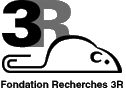
Andrew Hemphill and Nathalie Vonlaufen
Vetsuisse Faculty, Institute of Parasitology, University of Bern, 3012 Bern, Switzerland
hemphill@ipa.unibe.ch, vonlaufen@ipa.unibe.ch
Keywords: veterinary drugs; veterinary drugs; neosporosis; cell cultures: parasites; reduction; replacement; diagnostic approaches: parasites; diagnostic approaches: vaccines; veterinary drugs
Duration: 3 years Project Completion: 2003
Background and Aim
Neospora caninum is an obligatory intracellular apicomplexan parasite which causes abortion predominantly in cattle and neuromuscular disorders in dogs (Hemphill and Gottstein, 2000). The parasite has a life cycle composed of three distinct stages, namely the asexual tachyzoite and bradyzoite forms, and the sexually produced sporozoites. Tachyzoites are virulent and transmitted from the mother to the fetus. Bradyocytes form tissue cysts that are orally infective. They can transform in their hosts into the tachyzoite stage. Tachyzoites can be cultivated in vitro in the presence of various cell lines (Hemphill, 1999). Knowledge on suitable culture conditions for the other life cycle stages, however, is rather limited.
The aim of this project is to develop an in vitro cultivation system for generating N. caninum tissue cysts containing the respective bradyzoite stage. This will eliminate the need of animals for generating bradyocytes that can be used for e.g. primary drug screening experiments, the search for immunodominant antigens or studies on the basic cell biology of the parasite.
Method and Results
Cell culture derived N. caninum tachyzoites are grown for several cycles of infection within Vero cells. Parasites are isolated and monolayers of murine epidermal keratinocytes are infected. Infected cultures are then maintained in serum-free medium in the presence of 70 mM sodium nitroprusside for several days, and the conversion of the tachyzoites to bradyzoites is monitored by immunofluorescence, employing bradyzoite-specific antibodies. Quantitative Neospora-PCR revealed that nitroprusside treatment resulted in a distinct inhibition of parasite proliferation. After 8 days in culture, >60% of parasitophorous vacuoles had converted from the actively proliferating tachyzoite phase and were now expressing the bradyzoite antigen BAG1 and the cyst wall antigen CC2. Electron microscopical and biochemical analysis of these in vitro generated tissue cyst-like structures confirmed that stage conversion has taken place. This methodology is now applied to generate long term bradyzoite in vitro cultures, and the culture system has been modified for the use of Vero host cells. This allows for production and purification of larger numbers of N. caninum bradyzoites. Bradyzoite-infected monolayer cultures are currently evaluated for their use a a primary drug screening model. The efficacy of these drugs and possible bradyzoite-tachyzoite stage reconversion effects are monitored microscopically by immunocytochemistry, PCR and electron microscopy .
Conclusions and Relevance for 3R
An in vitro cultivation system for generating N. caninum tissue cysts harboring the bradyzoite stage of the parasite will reduce the number of laboratory animals currently used for this purpose. It will give researchers the opportunity of performing primary drug screening studies and other research on the general cell biology of N. caninum without the use of animals.
(see also 3R-INFO-BULLETIN Nr. 24)
Published updated Version 24/2007 (pdf)
References
1) Hemphill A. The host-parasite relationship in neosporosis. Adv Parasitol 1999;43: 47-104
2) Hemphill A. and Gottstein B. 2000. A European perspective of Neospora caninum. International Journal for Parasitology 30: 877-924
3) Naguleswaran, A., A. Cannas, N. Keller, N. Vonlaufen, G. Schares, F. J. Conraths, C. Björkman, and A. Hemphill. 2001. Neospora caninum microneme protein NcMIC3: Secretion, subcellular localization and functional involvement in host cell interaction. Infection and Immunity 69: 6483-6494.
4) Müller, N., N. Vonlaufen, C. Gianinazzi, S. L. Leib, and A. Hemphill. 2002. Application of real time fluorescent PCR for quantitative assessment of Neospora caninum infections in organotypic slice cultures of rat central nervous tissue. Journal of Clinical Microbiology 40: 252-255.
5) Vonlaufen, N., C. Gianinazzi, N. Müller, F. Simon, C. Björkman, T. W. Jungi, S. L. Leib, and A. Hemphill. 2002. Infection of organotypic slice cultures from rat central nervous tissue with Neospora caninum: An alternative approach to study host-parasite interactions. International Journal for Parasitology 32: 533-542.
6) Vonlaufen, N., N. Müller, N. Keller, W. Bohne, M. McAllister, C. Björkman, E. Müller, R. Calderi and A. Hemphill. 2002. Exogeneous nitric oxide triggers Neospora caninum tachyzoite-to-bradyzoite stage conversion in murine epidermal keratinocyte cell cultures, Int. J. Parasitology 32. 1253-1265.
7) Keller, N., A. Naguleswaran, A. Cannas, N. Vonlaufen, M. Bienz, C. Björkman, M. Bienz, W. Bohne, and A. Hemphill. 2002. Identification of a Neospora caninum microneme protein (NcMIC1) which interacts with sulfated host cell surface glycosaminoglycans. Infection and Immunity 70: 3187-3198.
8) Naguleswaran, A., A. Cannas, N. Keller, N. Vonlaufen, C. Björkman, and A. Hemphill. 2002. Vero cell surface proteoglycan interaction with the microneme protein NcMIC3 mediates adhesion of Neospora caninum tachyzoites to host cells unlike that in Toxoplasma gondii. International Journal for Parasitology 32: 695-704.
9) Hemphill A., Vonlaufen N., Naguleswaran A., Keller N., Riesen M., Guetg, N., and Alaeddine, F. (2004) Tissue culture and explant approaches to study and visualize Neospora caninum and its interactions with the host cell. Microscopy and Microanalyses: in press.
10) Vonlaufen N., Guetg N. Naguleswaran A., Müller N., Björkman C., Schares G., von Blumroeder D., Ellis J. and A. Hemphill. 2004. In vitro induction of Neosporea caninum bradyzoites in Vero cells reveals differential antigen expression, localization and host-cell recognition of tachyzoites and bradyozoites. Infection and Immunity 72/1: 576-583.